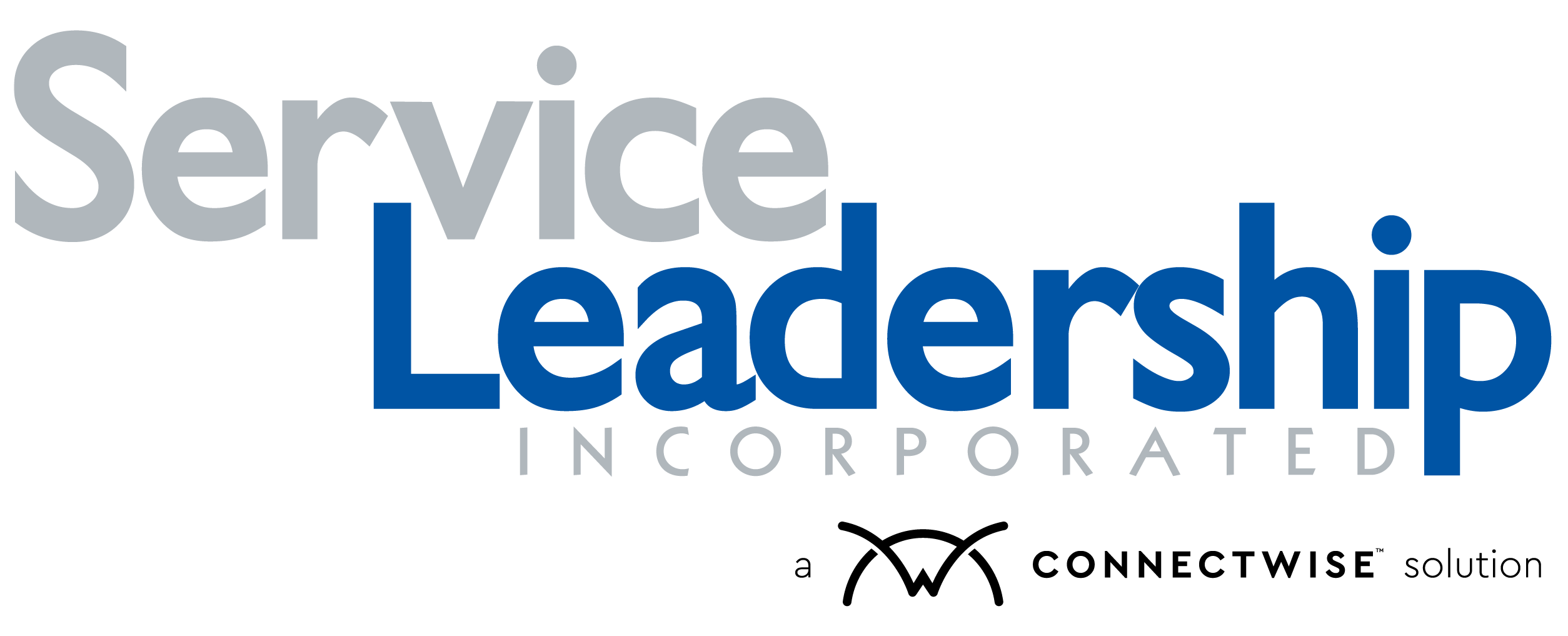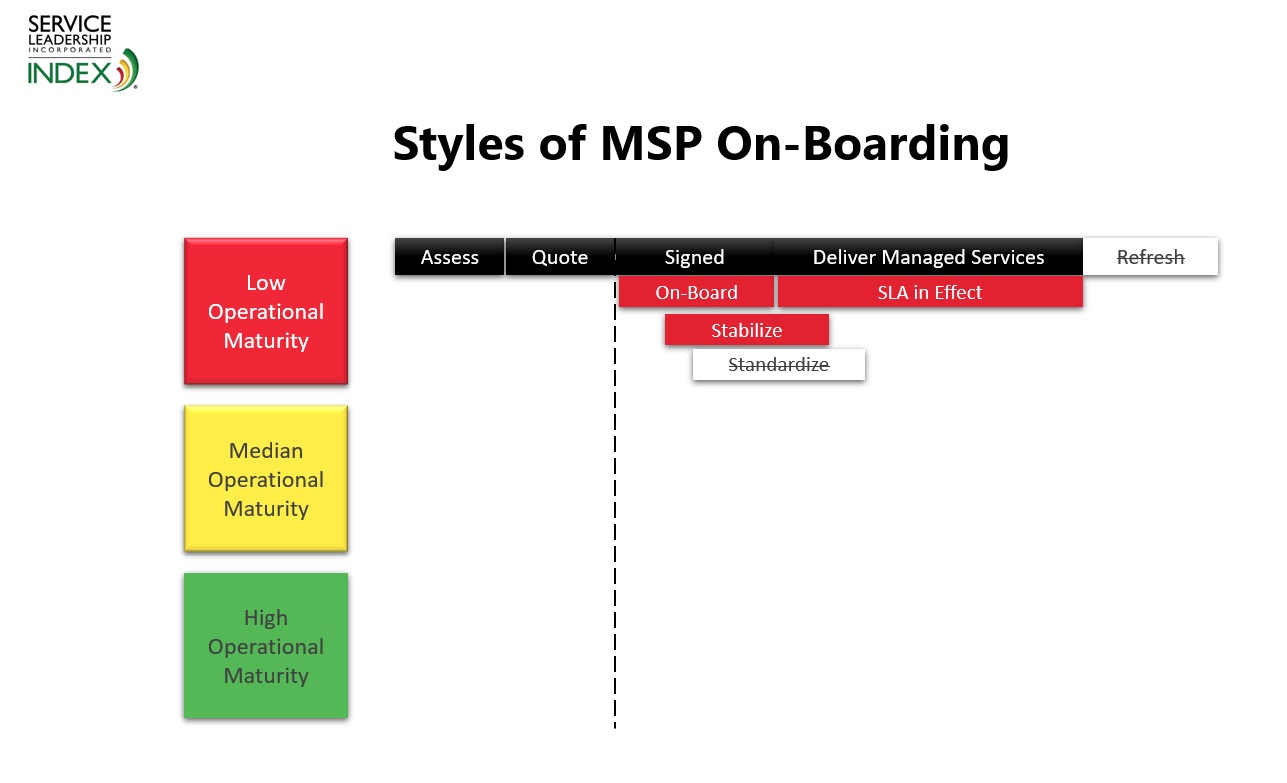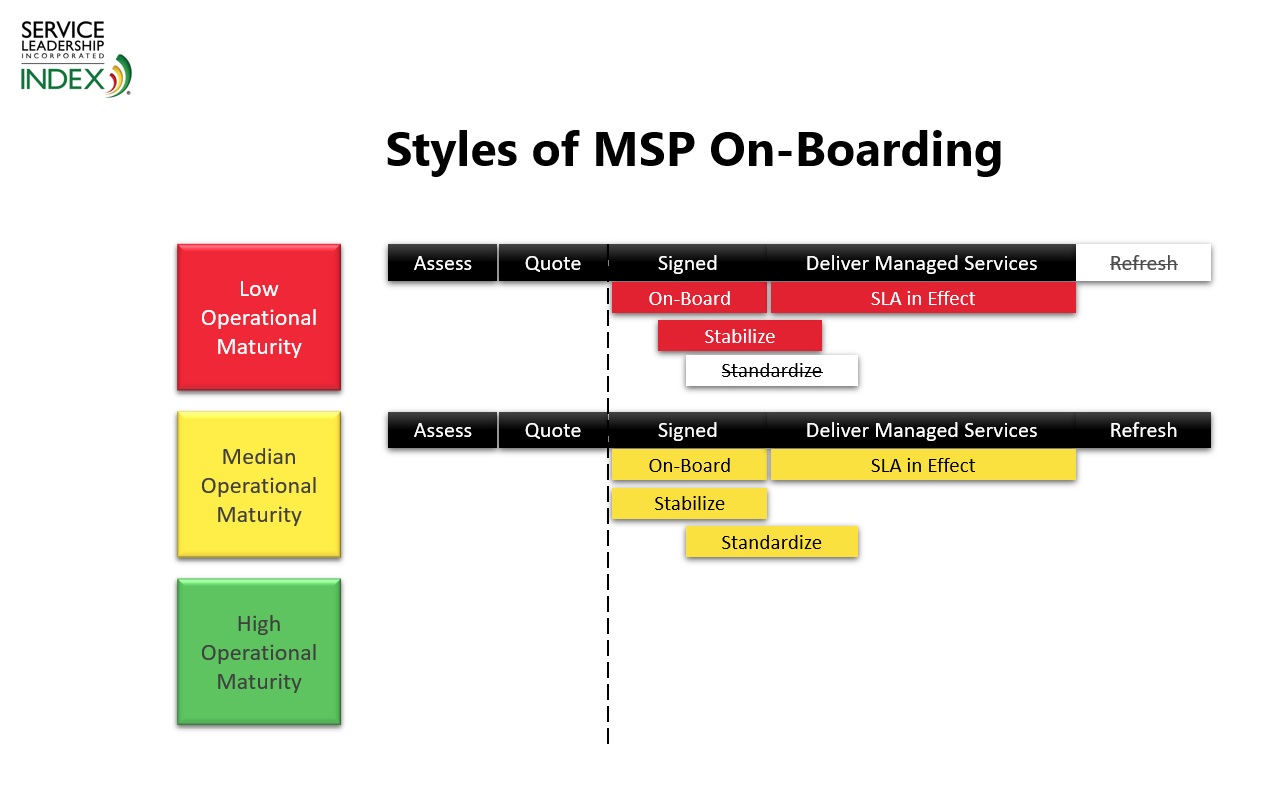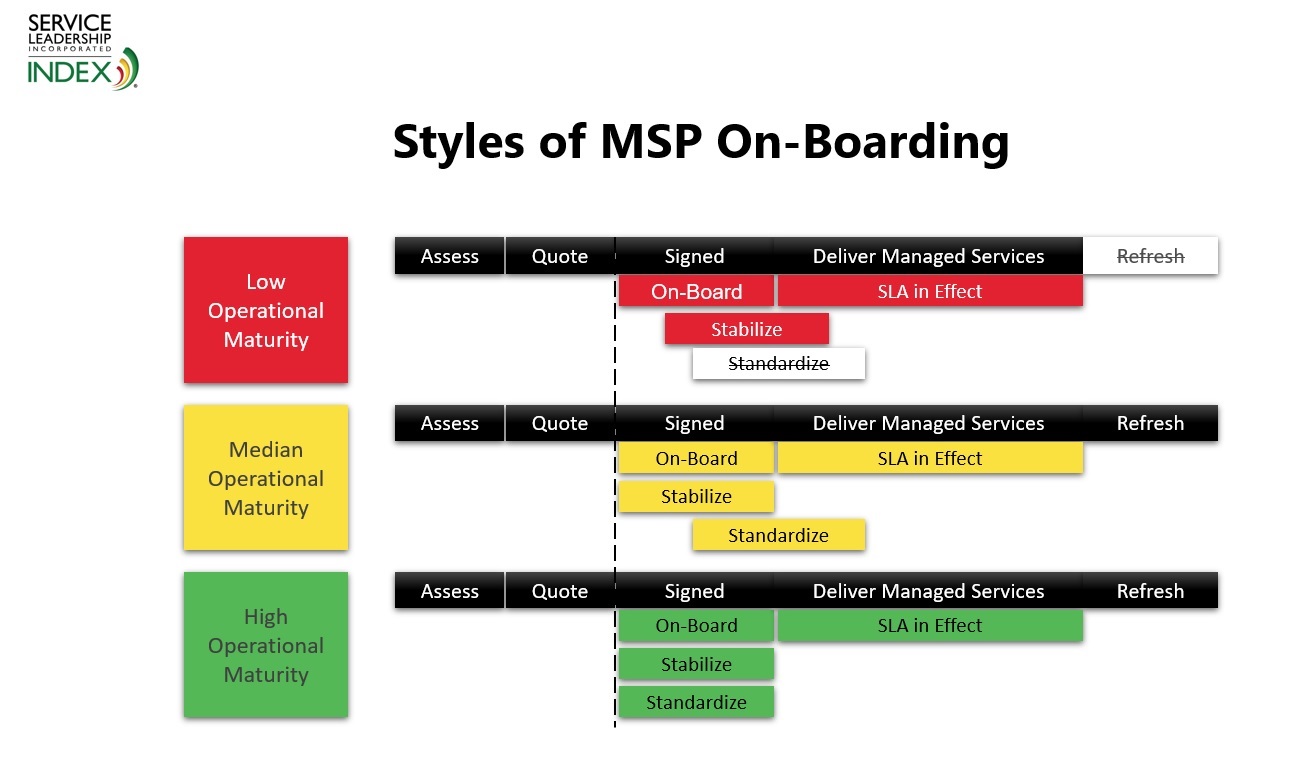The high OML MSPs use the customer’s general desperation to have better IT now, as the lever by which to get them to standardize now.
Of course, the high OML MSPs get their greater Revenue growth partially from requiring their customers to standardize fully right away:
- Their Service team is set up to provide great Service without impossible super-heroics, from the start.
- The customers get great Service from the start and over the longer term and provide more and better referrals,
- Customer retention and agreement to annual price increases are higher,
- The Sales people are more motivated to sell and more confident in their Sales motions.
It is likely that the lower OML competitors in the marketplace will tout their less-wise policies as competitive advantages. They may say something like: “We don’t make you standardize right away like those mean guys at <insert your company name here>. Unlike them, we have smart engineers who can handle your network as is (for now).”
This of course is the same tactic they will use with regard to your (higher) prices and your longer required contract term: “We know you’ll love us so much we’re willing to let you sign a month to month deal.”
Obviously, there is no magic to Managed Services. These less-capable MSPs are not magically providing great Service, making good money and building a happy, scalable business with these win/lose policies.
They are instead experiencing poor scalability, lower customer and employee retention, poor profits and poor growth.
The prospect that both you and your competition are trying to win must pass an intelligence test to become your customer, if you wish to build a profitable, scalable, growing and happy Managed Services operation. That test is standardization.
If they fail to pass that test, they will go to your competitor and have an unfortunate experience from which they will learn that you took the high road and told them the truth. They will be back, and they will be ready to agree to your win/win approach to the relationship. Meanwhile, there is no greater gift to give your competitor than a money-losing, pain-inducing customer.
Enforcing Technology Standards and Why You Need to Do It
Once you have defined your technology standards, you will then need to not only require, but enforce these standards internally and with your customers.
As you know by now, getting all your Managed Services customers onto your standard technology stack is critical to your Revenue growth, your Service quality (customer and employee happiness) and your profitability. For top performers, standardization is what they use to require compliance by all of their customers. Unfortunately, many low-performing MSPs know they should do this but struggle to “convince” customers to rip and replace equipment and software that does not meet their standards.
By now most customers are consciously or semi-consciously aware that IT manufacturers – especially software vendors – continually advance their products from Version 1 to Version 2 to Version 3, often accompanied by an upgrade fee. A given vendor may not call it a “version” but minor and major updates are a fact of life and mostly a desirable one.
A customer who is objecting to rip-and-replace is often consciously or semi-consciously expressing that they are at a vendor version level that is current or at least is satisfactory to them. Their error, when it comes to maintaining a win/win relationship with you, is that they often believe that current – or close to current or not very close at all – is good enough for them and therefore for you. They think the vendor is the arbiter of that decision.
The vendor is emphatically not the arbiter of that decision. You are. In saying “Yes’ to a Managed Services agreement, the customer is transitioning financial risk to you. It makes no more sense for them to expect you to accept their choice of equipment and software than it does for them to walk into a BMW dealer and ask to buy a new 5-Series but say:
“I would like your standard (all-inclusive four year) BMW Ultimate Service, but I would like you to remove your standard transmission and install my old Ford Cortina transmission because I like it better, it suits my purposes just fine, and I’m smarter than you are about transmissions anyway.”
The BMW dealer would never accept that from a customer. Even if the customer paid to have the old transmission installed (or the rest of the car “installed” around the old transmission) and paid some sort of “uplift”. This would kill the dealer’s ability to deliver quality Service and it would kill BMW’s reputation for quality. Plus, half of the dealer’s techs would quit and go to work somewhere that operated in closer alignment with sanity.
(It might be that you or some of your team may be convinced that standards aren’t good for the customer because “every customer needs a network custom-designed for their specific needs.” If so, we might suggest that this belief dates back to the days when system functionality was so crude and limited that customizations were needed to make the network even marginally valuable to the customer. With today’s products, the “built-in” functionality is so high that it’s entirely possible to have each customer’s network be 95% identical to the next customer’s – and the 5% variance be only in certain places – such that you have effectively attained production-level standardization. If you’re still a believer in the need for custom networks, can we suggest you may either be drinking vendor Kool-Aid or better off building a Project-Centric rather than Managed Services-Centric business.)
The good news is you can capitalize on this tendency of customers to calibrate their thinking to version numbers and simultaneously transfer their attention to vendor version numbers to you instead. Below is an example of a technique top-quartile MSPs (those with the highest growth, Service quality and profit) use to take the high ground in getting clients to standardize from the start.
Technique Top-Quartile MSPs Use to Set Standardization Expectations
One technique top-quartile MSPs employ to increase the proportion of times that prospects are closed with proper expectations of standardization is by using the “Business Optimization Architecture” method (see footnote below).
It starts with your conversations with the decision maker prospects. You say:
“Bob, one of the key values we add is that we are constantly researching new technology developments to incorporate into our efficient and effective technology design for our successful small business customers, so that you don’t have to guess what works, or expend R&D efforts yourself. We are currently at myMSPcompany Business Optimization Architecture version 4.2, which we’ll bring you up to as we get started.
This is how we provide this great Service level at this great budget, and how we can afford to stay ahead of you in your technology planning and budgeting. About every 18 months, we will upgrade you to the latest version of Business Optimization Architecture. You’ll know about it well in advance for your budget purposes because part of our Quarterly Business Reviews together is forward budget planning to keep your IT spending in the most efficient and effective support of your business goals.”
In one step, you have unhooked the customer from the vendors’ upgrade cycles and hooked them to yours, while simultaneously setting their expectations about full standardization during on-boarding and further establishing the value of your Quarterly Business Reviews.
It’s possible that some customers who views themselves as less reliant on technology, may say, “Yes, but I’m not interested in having the latest and greatest. I don’t need to be on the leading edge.” In which case, your response would be:
“Bob, I’m glad you said that because we’re in strong agreement about the leading edge. We’ve found from long experience that having the latest and greatest is a formula for higher costs and lower productivity in your business. You’ll almost never find us incorporating any vendor’s latest version in our Business Optimization Architecture, because the latest versions almost always have the most bugs and require us to have too many of the most expensive, high-skilled people.
We use our precious rocket scientists to evolve Business Optimization Architecture to keep you on the leading edge of productivity, cost effectiveness and protection against the unexpected, not the latest technology for technology’s sake. And through our Quarterly Business Reviews, you’ll always know three to four quarters in advance, what your IT budget will be. This is how we’ve come to win the confidence of many of the successful small businesses like yours, here in Smallville/Metropolis.”
Obviously, this is not a silver bullet that will work with every prospect. But, MSPs with top quartile profitability, growth and Service quality use this technique to leverage the customer’s understanding of “versions” to focus them on getting to their standards right away and for the long term, in a win/win fashion.
Progression Considerations
Progressing in this standardization project can occur rapidly and does so when the leadership of the Solution Provider comes to two realizations. The first is that they will need to drive towards a set of technical standards to organize how they think about, manage and market their business. This realization lays the groundwork for the second, more profound realization: They must drive these standards into their customers and prospects with real discipline. This happens with the decision not to take any more non-standard customers. Starting with your next prospect, the prospective client must agree to adopt your technology standards within a reasonable period of time or you cannot accept them as a customer.
While developing the standards can happen very quickly, driving these technology standards is most safely accomplished without skipping levels. Effective progression requires changing the culture to narrow the standards. You should also operate against these standards internally and evolve the Sales process and compensation to support the Sales team driving the installed base. You should also drive towards having prospective customers comply or pay a substantial premium for non-compliance. All of this takes disciplined, sequential improvement.
However, there are pitfalls in driving technical standards. The first is to make it an internally focused exercise, without understanding the market and competitive environment. Most notably what will it take to be the Solution Provider of choice to your target customer. Additionally, your Sales team needs to be retrained and fully enabled against your technology standards to most effectively use the standards to narrow their field of view to customers who will adopt your technology standards.
While Service drives the development of your technology standards, Marketing and Sales must drive those standards into your installed base of customers and prospective customers.
In addition to operational improvements, the Sales team also benefits in very real and measurable ways. As you begin to impose technology standards, keep an eye on key Sales metrics: cycle time to close, overall close rates, and average Monthly Recurring Revenue (MRR) per Managed Services deal. The Sales team may experience challenges until they have learned new prospecting, qualification and sales pitches. As the Sales team progresses, you will start seeing a markedly faster sales cycle, at higher prices and increasingly against more and more of your technology standards.
The costs of developing technology standards for each major solution segment is significant. In addition, you must consider the cost of keeping your technology standards updated as underlying technology vendors’ product offerings evolve. This can run 3% or more of Top (Best-in-Class) Solution Providers annual Revenues – in both hard costs and the soft costs of the manpower devoted to this task. As a result, these top performers seek to control this cost and speed time-to-market by partnering with relatively few vendors. Of course, the quality and completeness of the vendor’s standard architecture is also key to its value and usefulness.
If you need help standardizing your technology stack, please contact us to learn more about the tools and services available.



